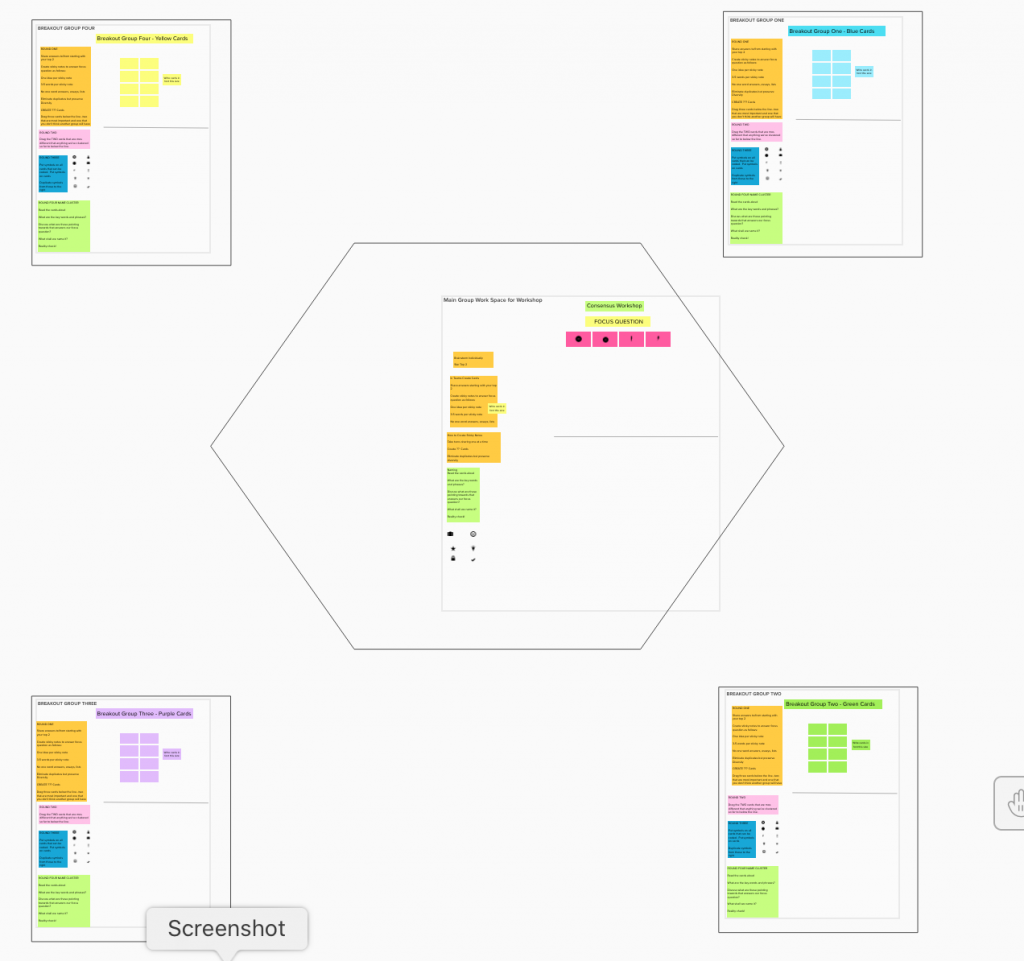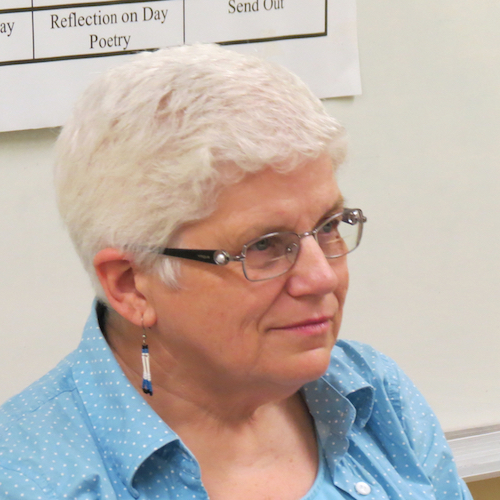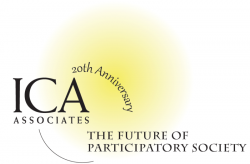This article is a compilation of brief stories of events that have been facilitated online, to inspire you with the possibilities. They range from simple and informal personal and family meetings, to complex work tasks. They were gathered from direct requests, a LinkedIn request, and participants in the May 2020 Canadian ToP Community of Practice.

Bill Staples
- One thing I recommend to phone or online facilitators is that they approximate a physical setting for the group. In an F2F space you often have to say “Ok, somebody on this side of the room can answer,” or “I haven’t heard anyone from the back of the room for a while.”
In order to approximate physical space for my recent session I did the following. I went to Powerpoint, made a large open circle and placed every persons’ name in large individual text blocks. At the beginning of the Zoom meeting, I shared the Powerpoint editing screen, and asked people where they wanted to be around the circle, N, NW, E, SE, W, etc. and placed their names there as they introduced themselves. As the last person introduced herself, I turned the share screen off and exported the page to a JPG. (30 seconds). Then I imported the circle with the names on them to my virtual background on Zoom and selected it.
Suddenly my screen changed from an ugly background to a circle with everyone’s name on it, with my head in the centre.
I used this throughout the session. “Let’s unmute all the folks in the northeast and hear what they have to say.” “Let’s go around the circle and answer, starting from Mandee in the Southeast and go clockwise.” - In June 2020 I was the speaker at the European Business Association meeting. I spoke to about 150 people on Zoom about the Map of the Organizational Journey. When I turned the floor back to Alexey and Oleg, both power ToP users from Ukraine, I saw them go to a Miro.com link on which there was an Org Journey map and several hundred red and green dots around the edge.The usual exercise with the Org Journey Map is for each participant put one colour of dots for where they experience the organization currently is on each of the 8 sections of the map. Then after discussion, to put a dot of another colour on each section where they want the organization to be.While I watched, not knowing what was going to happen because the instructions were in Russian, red dots started flying around the screen with tiny tags on them, guest1, guest2, about 60 guests. Within 2 minutes the entire OJ map was plastered with red dots in a recognizable pattern. There was a conversation in Russian, and the chat room filled up. A few minutes later the green dots started to fly across the screen.A few minutes later the MIRO screen had a complete Map of the Organizational Journey analysis with red dots showing the current state of business in the EBA, and green dots showing where they wanted to be. I was very privileged to have seen that.
Robin Parsons:
Process improvement (12 – 15 people)
Platforms: Zoom, MS Teams, Mural
Process: We inserted an obstacles conversation in process design work (not a typical approach)
Product: prioritized recommendations for improving a process
Impact on the group: The obstacles work was helpful in unlocking the groups blocks – which were primarily about how they related to each other. The group said things like “I’m so happy we have finally talked about this.” They were an IT team and did really well in a virtual environment (great skills). The group has prioritized their activity for improving their process.
Strategic planning (12 people); strategy, milestones, action plan
Platforms: Zoom, Mural
Process: Strategic Planning
Product: strategy, milestones, action plan
Impact on the group: They were really happy to have had the conversations and happy that they produced some concrete actions. Action planning was not of enough duration to give them a high degree of confidence that they could take a step forward. The leader has booked 4 follow up discussions to build on the momentum. The group really appreciated the way we did the virtual work.
Next up:
I’m planning a large (50 person) online event for the week of June 22
Product: Philosophies for a new industry network which include: aspiation, theory of change, collaborative philosophy, and volunteers for next phase
Platform: We will use Zoom and Google Slides (I think)
Mara Svenne
A colleague and I facilitated 5 separate sessions called Agility Health Assessment and Strategic Retrospectives for 5 different agile teams in May. The Agility Health Assessment is a team survey, that allows team members to self-assess where they fit on a number of agile competencies. After completing an anonymous assessment, the radar is displayed for the team in real time – and the team breaks out to discuss the qualitative measures (4 areas of the radar) and come up with recommendations.
We used Zoom and Mural. In mural – we coloured the background areas for each of 4 breakout rooms to match the colours on four parts of the Agility Health radar to allow each group to see easily where their post-it notes belonged. And the 4 mural areas were around a central, larger mural area – to allow the teams to easily drag their ideas into the ‘centre’. It made it look like smaller rooms clustered around a larger conference room.
When we brought the groups together, each breakout group dragged their top 3 recommendations to the centre mural and presented to the larger group.
Each of these sessions produced a set of 3-4 team or organizational ‘growth items’ (action items) to address over the next quarter.
These aren’t ToP methods; it’s a process recommended from the Agility Health organization for which I (and my colleague) are certified in as facilitators. These strategic retrospectives allow the agile teams to surface recurring patterns that they need help from their managers or other leaders to resolve, as well as having conversations about the things they want to do to help themselves.
The impact on the group was a.) they realized that there were things they could do to improve their team health and team outcomes – and that they had the ability and right to address it themselves. b.) The teams felt that these conversations were worth having (the workshops are 4 hours long; including the time it takes to complete the survey) – and the teams are typically in such a time pressure to deliver, that they struggled to find the space to do this reflection together.
The impact on myself and my co-facilitator was a realization that we could repeat this pattern online, rather than wait until distributed teams could travel to come face-to-face.
Michelle Rush
I have been using focused conversation almost continuously online… and recently used ‘Padlet’ to conduct a SWOT which worked really well. The focused conversation followed the gathering of SWOT data, via the Padlet link. Data was put in by participants ahead of the workshop which both saved time and helped with ‘buy-in’. The group enjoyed the novelty of using an online platform which was actually easy enough to use.
Carrie Blondahl
Our team has built a simple spreadsheet that includes the names of all attendees, and then a column for each ‘section’ of the workshop. Then the facilitator can mark on the list who has spoken and who hasn’t, so everyone gets a chance to be heard. It’s been very effective, and a very simple fix!
Carol Rosener
I have experienced webinars and they work fine with the comment feature. But I really liked my experience on Zoom. There were 50 some-odd people. They divided us into small groups, where we had the white board to track our responses and report out to full group. I also have Microsoft teams installed, but only have used it for a face to face interview.
Stories from the May Community of Practice Session
Used Zoom to do virtual mindfulness for staff. Launched last week for 22 people. Used Survey Monkey for feedback – positive feedback.
Used Zoom to celebrate 100th birthday. About 25 locations across time zones. Worked well.
Have used Google docs to share docs and maintain project. Use Google Reports to sign up/registration for sessions. Used Google Reports to manage sign up for mindfulness. Lots of use of Google docs for meeting notes and updates.
Check in with other 3 team members daily + weekly unit meetings
Randy Foster: Have 4-12 week courses for students, the school house for all army stuff, but students from all military services, agencies, and organizations. With switchover because of COVID-19 from face-to-face courses to online, had one week to design, one week to train instructors.
- Set up Zoom classroom M-F for 3 hours, assign readings in APAN (learning management system), have assignments that need to be turned into APAN. In the mornings, the instructors host discussions using ORID/Focused Conversations, use breakout rooms, do Consensus Workshop. In the afternoons use jigsaw classroom and break out rooms. The small groups work on problems. There is a lot of back and forth and by Thursday all teams come in to present.
- Phenomenology and grounded theory research- from this do survey to adjust and make improvements.
Rita Stagman: in the branch of Engagement and Education – part of the role of the job is to do facilitation. The branch quickly worked on increasing familiarity with online platforms.
- Working on a project on a taskforce developing recommendations to develop a “land plan” Near the end of developing recommendations with COVID-19 hit, but since they were nearing the end of their work they already had relationships built. Some of the last meetings online were fairly tedious because of the online format.
- Used polls while doing live edits….eg. on a scale of 1-6 where are you on this?
Paul Stern (facilitator)
- Like using mind map / mind manager
- Live sessions with participants’ ideas
- Used graphic/image-focused facilitation: What is the ultimate goal? What are the challenges in our way?
- This imagery approach resonated and sparked many connections with participants
Janelle
- Use online version of a board game with family…on Zoom.
- Great means to connect with family and friends
Pam Grahame
- Facilitated group focused on goal-setting
- Used polls/voting features and group discussion (audio/visual)
- Used screen-sharing and other aspects of online learning
- Experimented and used “failures” with the platform features to learn
- Investigated and used Zoom, Linoit, Mural (https://www.mural.co)
- One member had quite an emotional reaction and “Chat” function allowed people to be supportive and respectful
Ian Pettigrew
- Had the opportunity to work with a small group of “critical friends”, whom I met through a Zoom IAF Canada check-in meeting.
- This small group of “Facilitator Friends” has met once per week to “play” with facilitation techniques in an online setting
- Has afforded the opportunity to test things in a safe space.
Renaud Houzeau de Lehai
- Working with five directors to prioritize their action plans/strategic directions
- shared screen) to surface the action items (15-20).
- Transferred action items to sticky notes in Mural and harnessed a prioritizing matrix to make decisions (Note: drag-and-drop remained responsibility of Renaud as he listened to directors’ insights).
Barb MacKay
Here are some ORID Conversations for Covid-19 times that can be held online:





